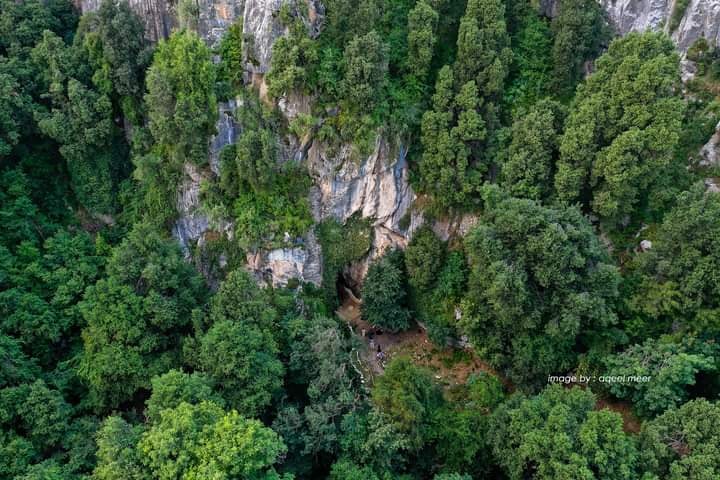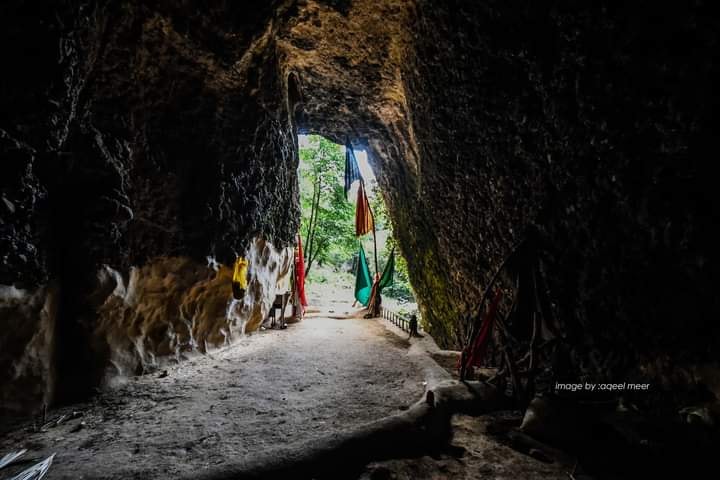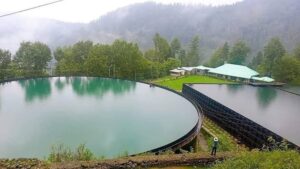PESHAWAR – Tucked deep within the rolling green hills of Dara Mani Khel in Orakzai Tribal District lies a natural wonder shrouded in mist, myths, and untapped potential. Nanawar Cave, one of the lesser-known yet most mesmerizing sites in Orakzai, drew swarms of local tourists this Eidul Azha—many of them unaware they were stepping into a living mystery still untouched by modern exploration.
Locals say the cave is around 200 meters long, but those who have dared to journey through its narrowing throat insist it stretches far beyond. “No one really knows where it ends,” said a local guide, pausing at one of the cave’s narrowing points. “The lack of oxygen makes it hard to reach the deepest parts.” And yet, that does not stop the adventurous from trying.

The cave, with two natural entrances and an interior height of 40 to 50 feet, breathes an eerie stillness. Its dark belly is home to thousands of bats and spiders. As one enters, the air grows colder and thinner. Water seeps from its ceiling in spots, fed by snow resting on the mountains above. “It’s not just a cave,” says Colonel Zakir Khan, Commandant Orakzai Scouts, “it’s a geological time capsule that deserves attention.”
Colonel Zakir, an avid supporter of eco and adventure tourism, believes the cave could anchor a new chapter for Orakzai. “It’s one of the most beautiful and tremendous natural caves in our region,” he says. “It could draw not just families, but Black Packers Societies and adventure seekers from all over the world.”
We went deep into the Nanawar cave which is home to thousands of bats. There are two entrance and a whole different world, inside the cave. #Orakzai #Pakistan #Tourism #FATA #KPK pic.twitter.com/QbD0gtqhkU
— Faiysal AliKhan (@FaiysalAliKhan) April 19, 2019
But what makes Nanawar truly compelling are the layers of legend and science that swirl around its creation. One belief holds that the cave formed thousands of years ago when a lava bubble solidified, leaving behind the hollowed structure we see today. Another theory suggests it’s a limestone cave linked to an underground water channel that surfaces in the summer. And then there are the tales of ancient graves nearby—unmarked, pre-Islamic.
Some say monks once meditated here during the reign of Kanishka in 127 CE.
The route to the cave isn’t easy. It takes a 25-kilometer trek—on foot—through walnut groves and hilly terrain to reach its mouth. But for those who make it, the reward is profound. “It’s peaceful, green, and unexplored. Our people need to see this part of Orakzai,” says a young student visiting the area for the first time.
#PAKHeavenForTourists
— Asim Afridi (@asim1685) August 1, 2019
ننور غار Nanawar Cave
65KM from Kohat City in Orakzai Agency pic.twitter.com/Msnm8uWZ3G
Despite its rugged charm, Nanawar remains undeveloped. There are no signs, no safety gear, no oxygen supply inside. Just you, the silence, and centuries of unanswered questions. Yet it is precisely this rawness that makes the cave irresistible.
The cave is already listed in the erstwhile FATA Tourism Development Authority’s future plans, and officials like Colonel Zakir are hopeful. “With proper development, this could be our region’s adventure capital,” he says. “It’s time people look beyond the usual tourist traps and discover the beauty and mystery of places like Nanawar.”
In a province known for its natural grandeur, Nanawar Cave stands apart—not just for what it is, but for what it could become. A monument of nature. A site of heritage. And maybe, just maybe, the next great adventure waiting to be written.












